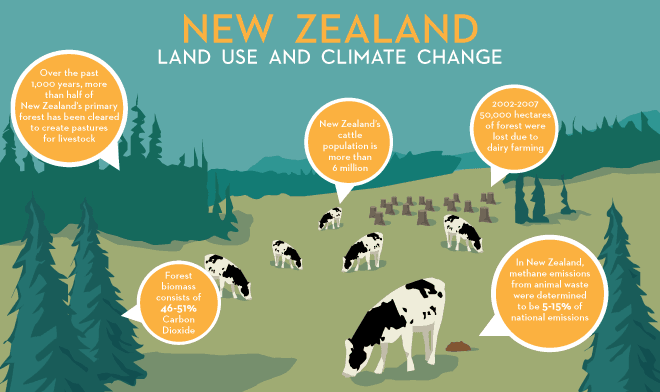Last spring, New Zealand-based research institute Landcare Research completed a study on the effects of shifting land use between temperate forest and grassland used as a grazing pasture for livestock. The results of the study show that growing livestock populations are contributing to methane emissions, and indicate the need for improved carbon sequestration methods. And more carbon can be sequestered, according to the report, by reforesting land that has been converted to pasture.
Over the past 1,000 years, both Polynesian and European settlers have cleared more than half of New Zealand’s primary forest to create pastures for livestock. Today, approximately 50,000 hectares of forest has been lost to dairy farming between 2002 and 2007, according to the study.
Landcare Research reports that this increase in deforestation is a big problem because it diminishes the amount of carbon dioxide that can be stored in forests. Carbon dioxide is the primary greenhouse gas emitted by human activities, and trees absorb it from the atmosphere. Forest biomass generally consists of 46-51 percent carbon dioxide, so when one tonne (1000 kg) of biomass is lost when a forest is converted to pasture, half of a tonne (500 kg) of carbon dioxide is released into the atmosphere. In order to offset this negative effect, New Zealand is planting trees in areas that were previously deforested to help reduce carbon dioxide concentrations in the atmosphere.
The government of New Zealand is also working to reduce methane emissions from livestock. Methane has a global warming potential 25 times greater than carbon dioxide. Ruminant livestock produce nearly 80 million metric tons (80,000 kg) globally of methane per year and in New Zealand, methane and nitrous oxide account for almost half of New Zealand’s greenhouse gas emissions. In New Zealand, methane emissions from animal waste were determined to make up between five and 15 percent of national emissions.
New Zealand’s cattle population is more than six million. To help reduce their greenhouse gas emissions, New Zealand government established the New Zealand Emissions Trading Scheme (ETS), following the Kyoto Protocol of the United Nations. Currently, the ETS provides incentives to individuals and businesses to help reduce greenhouse gases. These incentives remain in place for the agricultural industry as well. Additionally, the New Zealand Ministry for Primary Industries (MPI), the country’s main adviser on domestic and international agricultural policy, along with the New Zealand Pastoral Greenhouse Gas Research Consortium (PGgRc) and the Ministry of Business, Innovation and Employment (MBIE) help fund research to discover ways in which New Zealand can further reduce agricultural emissions.















